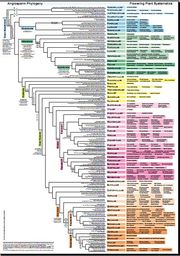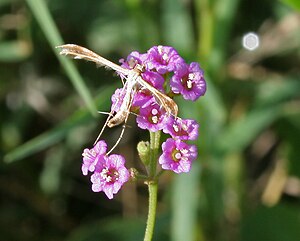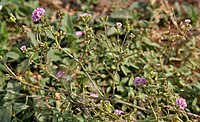Boerhavia diffusa
Read community contributed articles on biodiversity & environment || Cultural practices & mythological stories related to Indian biodiversity || Official documents related to environment || NGOs, Blogs and Websites || Environment-related video collection || Plants of India || Mammals of India || Facebook || Twitter
Share this page: Boerhavia diffusa
Boerhavia diffusa is a weed growing in many parts of India. It had edible leaves. Roots of this plant are used by many tribes in India for their analgesic and anti-inflammatory properties. The name Punarnava means that which rejuvenates. This plant is an ingredient of Dabur Chawanprash.
Click here to see all Semantic Properties associated with this page
Please note that the above slideshow is automatically created by searching Flickr and does not contain manually curated images. Hence, it is likely that some images may not be exactly of Boerhavia diffusa.
Click on the tabs below to know more...
- Species identity and nomenclature
- Current Wikipedia entry
- Binomial Classification
- Morphological features
- Habitat and Geographical Spread
- Maps
- Medicinal Importance
- Cultural significance
- Commercial importance and cultivation
- Summary of PubMed articles
- Summary of NCBI molecular data
- External Links
- Images and Videos
| Parameter | Value(s) | References See complete references in the References section at the end |
|---|---|---|
| Names of users who have contributed to this species page | Gauravm | |
| Date on which this page was first created | 2010/10/22 | |
| This page was last modified on: | 24 November 2010 02:40:07 | |
| Name of the species | Boerhavia diffusa | |
| ID on Encyclopedia of Life | 488528 | |
| Synonyms | Please check Binomial Classification section for synonyms. | |
| Common English Names | Red hogweed, Tar Vine, Red Spiderling, Wineflower | |
| Common Hindi Names | Punarnava, Satha | |
| Common Indian names | Punarnava, Satha (Hindi);Adakaputtana gida (Kannada) | Flowers of India |
| Origins/Meanings of the common names | The name Punarnava means that which rejuvenates or renews the body | Wikipedia |
Taxonomy from Encyclopedia of Life
If nothing is displayed in this section, it means the EoL ID has not been defined. Please click on Edit with form button on top and follow the instructions for filling in the EoL ID
{{#EoLOnlyHierarchy:488528}}
Taxonomy filled in form

Click here for the PDF of the phylogeny
| Taxon | Value |
|---|---|
| Regnum (Kingdom) | Plantae |
| Division | Magnoliophyta |
| Class | Magnoliopsida |
| Order | Caryophyllales |
| Family | Nyctaginaceae |
| Genus | Boerhavia |
| Source of data | Encyclopedia of Life |
| ||||||||||||||||||||
| Division | Taxon details | Taxon morphology details |
|---|---|---|
| Magnoliophyta | Also called Angiospermae. The ancestors of flowering plants diverged from gymnosperms around 245–202 million years ago, and the first flowering plants known to exist are from 140 million years ago. They diversified enormously during the Lower Cretaceous and became widespread around 100 million years ago, but replaced conifers as the dominant trees only around 60-100 million years ago. | These are seed plants like Gymnosperms, but can be differentiated by the presence of flowers, seeds containing endosperm and seeds that produce a fruit. Angiosperms are the most diverse and highly evolutionarily successful group of land plants. |
| ||||||||||||||||||||
| Class | Taxon details | Taxon morphology details |
|---|---|---|
| Magnoliopsida | Magnoliopsida is the scientific name for dicots. This class contains about ~1,99,350 species of Angiosperms. Eudicots are a subset of Dicots. Based on chloroplast DNA sequences, the divergence date between monocots and dicots is estimated to be ~200 million years, with a 40 million years uncertainty. | Dicots are diverse in habit, with half of all the species being more or less woody-stemmed - a reflection of the usual presence of a vascular cambium in the class. Annuals, biennials, vines, epiphytes, aquatics, parasites, and saprotrophs are also well represented in dicots. Vascular bundles of the stem are usually borne in a ring that encloses the pith. Vessel elements present except in some putatively primitive woody or aquatic families. Most dicots have a primary root system derived from the radicle, although some have an adventitious root system commonly seen in the class of monocots. Cotyledons are usually 2, seldom 1, 3, or 4. Leaves are mostly net-veined. |
|
|
|
Based on classification
More details can be found in the Binomial Classification section.
Morphology from Encyclopedia of Life
If nothing is displayed in this section, it means the EoL ID has not been defined. Please click on Edit with form button on top and follow the instructions for filling in the EoL ID
{{#EoLOnlyDescription:488528}}
General morphology
| Parameter | Value(s) | References See complete references in the References section at the end |
|---|---|---|
| General morphological features of the plant | Herbs perennial. Stems trailing, to 200 cm; stems glabrous or sparsely pubescent. Roots thick, fleshy. Petiole 0.4-2 cm; leaf blade ovate, 1-5 × 1-4 cm, both surfaces sparsely pubescent, abaxially gray-yellow, wrinkled when dry, base rounded or cuneate, margin undulate, with stout, muticellular hairs, apex obtuse or acute. Inflorescences terminal, capitate-cymose panicles; peduncle slender, sparsely pubescent. Pedicel short to almost absent. Bracts small, lanceolate, pubescent. Perianth limb bright purple or purple-red, 1.5-2 mm. Stamens 1-3(-5), slightly exserted or included. Anthocarp clavate, 3-3.5 mm, 5-ribbed, with viscid glands and sparse pubescence, apex rounded."Herbs perennial. Stems trailing, to 200 cm; stems glabrous or sparsely pubescent. Roots thick, fleshy. Petiole 0.4-2 cm; leaf blade ovate, 1-5 × 1-4 cm, both surfaces sparsely pubescent, abaxially gray-yellow, wrinkled when dry, base rounded or cuneate, margin undulate, with stout, muticellular hairs, apex obtuse or acute. Inflorescences terminal, capitate-cymose panicles; peduncle slender, sparsely pubescent. Pedicel short to almost absent. Bracts small, lanceolate, pubescent. Perianth limb bright purple or purple-red, 1.5-2 mm. Stamens 1-3(-5), slightly exserted or included. Anthocarp clavate, 3-3.5 mm, 5-ribbed, with viscid glands and sparse pubescence, apex rounded." cannot be used as a page name in this wiki. | EoL through eFloras |
| Seed dispersal mechanism | Entomophily (By insects) | |
|---|---|---|
| Bloom type | Perennial | |
| Life cycle of the plant | Fl. and fr. spring-autumn. | EoL through eFloras |
How to identify this species
For a detailed description, refer to the General Morphology details above
| Parameter | Value(s) | References See complete references in the References section at the end |
|---|---|---|
| Type of plant | Herb | |
| Plant height | Up to 3 feet | |
| Flower color | Blue, Lavender/Purple | |
| Flower shape | ||
| Floral symmetry | Radial | |
| Phyllotaxy of leaves | ||
| Leaf shape | Ovate | EoL through eFloras |
| Is the leaf petiolated or sessile? | Petiolated | EoL through eFloras |
| Is the leaf simple or compound? | Compound | EoL through eFloras |
| Parameter | Value(s) | References See complete references in the References section at the end |
|---|---|---|
| IUCN Conservation Status | ||
| Indian States in which the species has been documented | ||
| Locations at which the species has been documented | ||
| Biotic zones inhabited | ||
| Details about the habitat | B. diffusa is widely dispersed, occurring throughout India, the Pacific, and southern United States. This wide range is explained by its small fruit, which are very sticky and grow a few inches off the ground, ideally placed to latch on to small migratory birds as they walk by. | Wikipedia |
| Is this species native to India? | Yes | |
| Is the species indigenous/endemic to Sub-Himalayan regions? | ||
| Is the species indigenous/endemic to Western Ghats? | ||
| Is the species indigenous/endemic to Eastern Ghats? |
More plants native to India
| ||||||||||||||||||||||||||||||||||||||||||
If no maps are displayed below, it means the required data is absent. Click on "Edit with form" button on top of the page to add this information.
| Parameter | Value(s) | References See complete references in the References section at the end |
|---|---|---|
| Does this species have any medicinal use? | Yes |
|
Other plants of the same family having medicinal use:
|
| Parameter | Value(s) | References See complete references in the References section at the end |
|---|---|---|
| General types of ailments this species is used for treating | Common ailments, Organ-specific disorders | |
| Specific ailments for which the species is used | this herb is reported to be effective in:
>Stomach ache, >Anemia, >Cough, and cold, >Diaphoretic, >Laxative, >Potent antidote for snake and rat bites >Nephrotic syndrome >Hepatitis, >Gall bladder abnormalities >Urinary disorders >The flowers and seeds are used as contraceptive |
L P Awasthi and H N Verma : agri-history.org |
| Medicinal systems which use this plant | Ayurveda, Folk Medicine | |
| Details of Medicinal use | Charaka Samhita and Sushrita Samhita, describes preprations made form punarnava namely:
>punarnavastaka kvath, >punarnava kshar >punarnava taila > roots of this plant is used for the treatment of piles by the inhabitants of the Garhwal Himalaya (Uttaranchal). >A paste made from roots of this plant is for the treatment of bloody dysentery by the Bhils tribals of the Jhabua district in Madhya Pradesh. >The juice made form roots is used in against asthma, scanty urine, and internal inflammation disorders. >Use of this plant has also been reported to cure ailments such as leukorrhea, rheumatism, and stomach ache by the Sahariya tribe in the Lalitpur district of Uttar Pradesh. >Tribes from Ambikapur district (Madhya Pradesh) use it against elephantiasis. In the Indo-Nepal Himalayan terai region, this plant is used by tribals for flushing out the renal system, and to treat seminal weakness and blood pressure. |
L P Awasthi and H N Verma : agri-history.org |
| Parts of the plant used for treatment | Root, Leaves | L P Awasthi and H N Verma : agri-history.org |
| Names of some medicinal active compounds in this plant, if known. | >>This plant contains a large number of compounds like flavonoids, alkaloids, steroids, triterpenoids, lipids, lignins.
>>Other molecules isolated and studied from this plant are > Punarnavine (Agarwal and Dutt, 1936; Basu et al., 1947; Surange and Pendse, 1972), >Boeravinone A.F (Kadota et al., 1989; Lami et al., 1990; 1992), >Hypoxanthine 9-L-arabinofuranoside (Ahmad and Hossain, 1968), >Ursolic acid (Mishra and Tiwari, 1971), >Punarnavoside (Jain and Khanna, 1989), >Liirodendrin (Aftab et al., 1996) |
L P Awasthi and H N Verma : agri-history.org |
| Details of the active chemical compounds found in this plant | ‘Punarnavoside’ found in roots of B. diffusa is a new antifibrinolytic compound. | L P Awasthi and H N Verma : agri-history.org |
| Is the molecular basis of the medicinal action known? | ||
| Details of molecular basis of action | The active principle active compound found in this herb is an alkaloid, known as
punarnavine. |
L P Awasthi and H N Verma : agri-history.org |
| Are the toxic effects of consumption of this plant known? | ||
| Details of the toxic effects of the plant species | ||
| Have there been validation/clinical studies related to this plant? | ||
| Details of the clinical studies related to the plant species | >A drug named as punarnava, has been prescribed in Indian Pharmacopoeia as a diuretic
>An aqueous extract of thinner roots of has been shown to protect various enzymes such as serum glutanicoxaloacetic transaminase, serum glutanic-pyruvic transaminase, and bilirubin in serum against hepatic injury in rats. > Extract form this plants has been studied vastly for their ability to Prevent and control viral diseases of crops in fields. |
L P Awasthi and H N Verma : agri-history.org |
| Parameter | Value(s) | References See complete references in the References section at the end |
|---|---|---|
| Is this plant/plant-derived product used in food preparations? | Yes | User-reported |
| Part(s) of the plant used in the food preparations | Root, Leaves | |
| Details of use in food preparations | >Roots is eaten as vegetable, in curries and soups.
>It is used as bird feed or poultry feed. >This plant is used as feed to sheep, goats, and cows, and in West Bengal and is believed to enhance lactation period and also the amount of milk in cattle. |
|
| Does this species have any religious significance? | ||
| Religions which mention/give significance to this species | ||
| Religious occasions | ||
| Details of religious use |
| Parameter | Value(s) | References See complete references in the References section at the end |
|---|---|---|
| Is this plant cultivated commercially in India? | Yes | |
| Uses for which the plant is commercially cultivated | Human consumption, Animal consumption, Medicinal use | |
| Plant parts of commercial value | Entire plant, Root, Leaves | |
| Products where this plant is used | User-reported | |
| Description of use | ||
| States where this plant is cultivated commercially | Assam, Bihar, Madhya Pradesh, Uttarakhand, Uttar Pradesh, West Bengal | shwetank |
| Best period for planting this plant | ||
| Best period for harvesting this plant | ||
| Method of propagation | ||
| Water requirement of this plant | ||
| Pests and Diseases affecting this plant during cultivation | ||
| Other considerations while cultivating this plant |
Pubmed Word cloud
This word cloud is obtained using the tool LigerCat by searching the Pubmed database. LigerCat builds the cloud from the most relevant Medical Subject Headings (MeSH) terms. Each term's relative size indicates how many times it appears in the PubMed search results. Click on a term to access the full LigerCat cloud, with live PubMed search capabilities. LigerCat has been developed for the Biology of Aging Project.
The page may take some time to load since LigerCat is searching the entire PubMed database and sending us the results in real time.
- If there is an error message below, it means that there is no retrievable information available on NCBI
- If the number of nucleotide sequences is less than 100, very little genomic work has been done on this species. A respectable number of nucleotide sequences is above 10000.
- Most of the nucleotide sequences may come from three sources:
- Studies on single genes, where people try to sequence genes such as some specific dehydrogenases important,say, for tannin production
- Sequences of Ribosomal Internal Transcribed Spacer, whose sequence is used for generating molecular phylogenetic trees to establish species relationships
- Expressed Sequence Tags (ESTs) which can tell about which genes are present and expressed in the species at a particular time in the given tissue
{{#queryDB:taxonomy |Boerhavia diffusa }}
| Parameter | Value(s) | References See complete references in the References section at the end |
|---|---|---|
| Details of modern scientific knowledge available for this species | ||
| Are herbarium specimen available for this species? | ||
| Institutes having herbarium samples | Royal Botanic Gardens, Kew (UK) | Royal Botanic Gardens, Kew (UK) |
If nothing is displayed in this section, it means the EoL ID has not been defined. Please click on Edit with form button on top and follow the instructions for filling in the EoL ID
{{#EoLOnlyAdditionalInfo:488528}}
References
boerhavia diffusa properties (Journal) : L P Awasthi1 and H N Verma ({{{year}}}),Boerhaavia diffusa – A Wild Herb with Potent Biological and Antimicrobial Properties, Asian Agri-History:{{{volume}}}({{{issue}}}):{{{page}}}. doi={{{doi}}}
EoL (Web): Encyclopedia of Life entry, Accessdate=2010-10-23
eFloras (Web): eFloras of China, Accessdate=2010-10-23
Wikipedia (Web): Wikipedia entry, Accessdate=2010-10-23
Flowers of India (Web): Flowers of India, Accessdate=2010-10-23
{{{refkeyword}}} (Web): [{{{url}}} {{{title1}}}], Accessdate={{{year}}}-{{{month}}}-{{{date}}}

